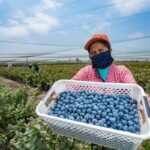U.S.: APHIS looks to streamline phytosanitary rule process

The United States Department of Agriculture (USDA) will soon announce an overhaul of the rule-making process for its Animal and Plant Health Inspection Service (APHIS), the agency confirmed.
APHIS serves as the regulatory body responsible for protecting U.S. agricultural health, which includes the implementation of phytosanitary rules to guide import and export procedures.

Customs and Border Protection agriculture specialists and APHIS employees examine shipments of fresh fruits and vegetables arriving at a New York port of entry.
In carrying out this enormous task, the agency has found itself reinventing the wheel. A currently disjointed system requires agency staff to rewrite and publish individual rules for each new commodity and location.
A pending streamlining process, however, could soon save APHIS time and money, public affairs specialist Yindra Dixon told www.freshfruitportal.com.
The proposed rules, expected for publication in 30-60 days, would allow APHIS to create a template to start from. From there, if safety risks were identified, agents would have the ability to add necessary rules to the pre-established framework.
The changes would have implications for cold treatment processes, fumigation requirements and other compliance agreements made for the U.S. and with trade partners.
Dixon said the changes would specifically impact sections 305.6 and 305.9 under the Code of Federal Regulations found in 7CFR305, which regulates phytosanitary treatment.
Domestically, for example, the standardized rules would create a starting point to evaluate new cold treatment facilities, a process currently complication by an exemption system.
“One of the things that’s highlighted in the specific rule is cold treatment facilities in the southern and western states. Our regulations actually say, if you are below a certain latitude and east of a certain longitude, you cannot have a cold treatment facility, unless there’s an exemption,” Dixon explained.
The process has resulted in many similar rules written and rewritten for exempt facilities.
“After years and years of doing that, we realized that we should look at this more from a big picture perspective and make a change that isn’t location specific but that specifically says, these are the requirements you need to set up a cold treatment facility. Assuming you meet all of these requirements, you can set one up, despite where you are,” she said.
The change would also mean the same starting point for a facility in Texas as for a facility in Peru.
“Right now, for example, we set up a specific compliance agreement with a fumigation facility in Peru, assuming that they do fumigation in Peru, and that compliance agreement really isn’t that different than the compliance agreement we set up in say Brownsville, Texas, but we just do two separate things and we go through the whole rule-making process in order to establish those agreements,” Dixon said.
“No we’re saying, that’s kind of goofy, let’s have standardized compliance agreements.”
If the new rules are implemented, locations with stricter requirements may see APHIS ease back.
“If it’s not a high risk, then essentially you would go to the more general provisions,” Dixon said.
Once published, the rule changes will be open to the standard 60-day comment period.
Photos: R. Anson Eaglin, APHIS














































